From Single-Use Community Facilities Support to Integrated Sustainable Development: The Aims of Inter-Municipal Cooperation in Poland, 1990–2018
Abstract
1. Introduction
2. Conceptual Background
3. Materials and Methods
- Common spatial or strategic planning,
- Common interest representation or promotion (both tourist and investment promotion, lobbying of higher public authorities),
- Social or human capital development (social inclusion, education and training, support for local voluntary organisations and cultural affairs),
- Enterprise (entrepreneurship) or employment development (local product development, local services development, enhancing employment),
- Tourism or recreation (small tourist and sport infrastructure, support for agro-tourism),
- Social services or infrastructure (refurbishment of public buildings such as social welfare establishments, voluntary fire brigade buildings, pavements, playgrounds, neighbourhood schools and kindergartens, public transport services),
- Technical infrastructure or roads (water supply systems, gas and electricity networks, internet networks, car parks and roads),
- Environmental protection or ecological infrastructure (sewage systems, sewage treatment plants, thermo-modernization of public buildings, ecological waste management, nature conservation).
4. Results
5. Discussion
- In the first phase after communism, the fragmentation of local self-governments created networks that were focused on fulfilling immediate physiological needs in underdeveloped areas (water and gas supply, waste management, etc.) and, accordingly, it was primarily sectoral, Special Purpose Unions that were created (Bennet’s “early network”). The priorities were related to the main municipal functions. The extension of market relations made municipalities group together for economies of scale in management of resources, especially where natural environmental areas and economic links crossed local administrative boundaries. There were some features of bottom-up territorial development, however, the voluntary and business sectors were not included widely in the process of strategic planning and decision making. The government, even when decentralised, did not want to lose power. In that period, local government tended to regard Non-Governmental Organisations (NGOs) as rivals and a potential threat to their own influence and, at best, as not to be trusted collaborators [100]. This is perhaps not surprising as NGOs and local governments have often been on opposing sides in spatial planning conflicts [101,102]. Democratisation after 1990 gave local communities in Poland new freedoms and responsibilities, but modes of behaviour associated with the socialist system did not disappear and tended to co-exist alongside the new organisation of the state, as noted by Regulska [103] and Grosse [92]. Nonetheless, voluntary organisations did develop strong relationships with local authorities so that by the end of the 1990s local authorities had emerged as the most common supporter of NGOs [100]. However, support did not mean wide engagement in the management of municipal resources.
- When, through national administrative reform measures, new levels of self-governance were created in 1999—the districts (powiat) and regional councils (województwo)—local municipalities were mobilized to establish the regional and local associations to enhance their capacity to lobby regional and central government. The new bodies engaged more with business, tourism and social and human capital than had their predecessors. However, they remained mono-sectoral, municipal organisations with a relatively narrow list of aims and can be considered also as examples of Bennet’s “early network”.
- The last phase began after accession to the European Union, with minor changes at the beginning of EU programming periods. The creation of new forms of territorial cooperation with local municipality engagement were clearly stipulated by the EU policies and funds (Bennett’s phase of “developing trust” between collaborators, with external agency support). The new forms were created mainly at the beginning of the support programmes, which provided a powerful incentive for their organisation. Such arrangements had scarcely been established prior to funding being available, so cannot be considered as a genuine national self-organisation process, but rather as policy transfer of the concept of place-based development. It can be considered also as “Europeanisation”; in this case, a conscious process of territorial development policy transfer to post-socialist countries led by European Union policymakers [43,104]. Funds and programmes originating in Western Europe played a significant role in mobilising local stakeholders to create partnerships and provide technical assistance, funding and investment possibilities. This process was common across all new EU member post-socialist states in Central and Eastern Europe [78,105,106].
6. Conclusions
- First, the process of area-based partnership creation in post-socialist EU member states was a conscious process of place-based or neo-endogenous development policy transfer, considered as an element of the process of Europeanisation. The rapid development of territorial partnerships is self-evidently the result of special EU financial support policy (supporting the theory of rational choice [108]) and it is therefore difficult to predict the long-term durability of the sponsored organisations if this support is reduced or terminated;
- Second, the evolution of inter-municipal cooperation in transitional post-socialist Poland has more of a step character than the longer-term evolution associated with countries with longer experience of democratic local self-government. The main stages were initiated by radical legislative changes (creation of self-government in 1990, administrative reform implemented in 1999, and joining the European Union in 2004 with its consequences in terms of changed policies in their programming periods);
- Third, the territorial cross-sectoral partnerships are most frequently forms of inter-municipal cooperation that have more sustainable and integrated features of development planning than mono-sectoral forms led solely by government, and are taking more account of social and small business issues;
- Fourth, the three forms of cooperation present some features of specialisation—SPUs focus most commonly on “hard” infrastructure and waste management; MAs on “soft” actions like common municipal representation and promotion and public administration development; LAGs on social and human capital building, small business development, tourism and recreation;
- Finally, the new forms of cooperation do not replace the old ones, but can and do exist simultaneously. However, the greater potential of area-based cross-sectoral partnerships (such as LAGs) has become increasingly evident.
Author Contributions
Funding
Conflicts of Interest
References
- Adaptative Co-menagement: Collaboration, Learning and Multi-Level Governance; Armitage, D.F., Berkes, F., Doubleday, N., Eds.; University of British Columbia: Vancouver, Canada, 2007. [Google Scholar]
- Simard, J.-F.; Chiasson, G. Introduction: Territorial governance: A new take on development. Can. J. Reg. Sci. 2008, 31, 471–485. [Google Scholar]
- Stead, D. The Rise of Territorial Governance in European Policy. Eur. Plan. Stud. 2014, 22, 1368–1383. [Google Scholar] [CrossRef]
- Ray, C. Neo-endogenous rural development in the EU. In Handbook of Rural Studies; Cloke, P., Marsden, T., Mooney, P., Eds.; Sage: London, UK, 2006; pp. 278–291. [Google Scholar]
- Canete, A.J.; Navarro, F.; Cejudo, E. Territorially unequal rural development: The cases of the LEADER Initiative and the PRODER Programme in Andalusia (Spain). Eur. Plan. Stud. 2018, 26, 726–744. [Google Scholar] [CrossRef]
- Scott, M. Delivering Integrated Rural Development: Insights from Northern Ireland. Eur. Plan. Stud. 2002, 10, 1013–1025. [Google Scholar] [CrossRef]
- Zaucha, J.; Świątek, D. Place-Based Territorially Sensitive and Integrated Development; Ministry of Regional Development: Warsaw, Poland, 2013. [Google Scholar]
- George, C.; Reed, M.G. Operationalising just sustainability: Towards a model for place-based governance. Local Environ. 2015, 22, 1105–1123. [Google Scholar] [CrossRef]
- Bosworth, G.; Annibal, I.; Carroll, T.; Price, L.; Sellick, J.; Shepherd, J. Empowering Local Action through Neo-Endogenous Development; The Case of LEADER in England. Sociol. Rural. 2016, 56, 427–449. [Google Scholar] [CrossRef]
- Markowski, T. Territorial dimensions of integrated development policy—Expectations and challenges concerning planning and institutional systems. Stud. Reg. 2013, 35, 51–64. [Google Scholar]
- Therese, B.; Sandström, C. Public-private partnerships in a Swedish rural context—A policy tool for the authorities to achieve sustainable rural development? J. Rural Stud. 2016, 49, 58–68. [Google Scholar]
- Kis, K.; Gal, J.; Veha, A. Effectiveness, efficiency and sustainability in local rural development partnerships. APSTRACT Appl. Stud. Agribus. Commer. 2012, 6, 31–38. [Google Scholar] [CrossRef]
- Gorlach, K.; Adamski, T.; Klekotko, M. Poland: Designing Nature and Resource Management Strategies. In Rural Sustainable Development in the Knowledge Society; Bruckmeier, K., Tovey, H., Eds.; Ashgate: Surrey, UK, 2009; pp. 187–202. [Google Scholar]
- Macken-Walsh, Á.; Curtin, C. Governance and Rural Development: The Case of the Rural Partnership Programme (RPP) in Post-Socialist Lithuania. Sociol. Rural. 2013, 53, 246–264. [Google Scholar] [CrossRef]
- Kaczmarek, T.; Kociuba, D. Models of governance in the urban functional areas: Policy lessons from the implementation of integrated territorial investments (ITIs) in Poland. Quaest. Geogr. 2017, 36, 47–64. [Google Scholar] [CrossRef][Green Version]
- Doitchinova, J.; Stoyanova, Z. Activation of local communities for development of rural areas. Econ. Agric. 2014, 61, 661–675. [Google Scholar] [CrossRef]
- Inter-Municipal Cooperation in Europe; Hulst, R., van Montfort, A., Eds.; Springer: Dordrecht, The Netherlands, 2007. [Google Scholar]
- Inter-Municipal Cooperation in Europe: Institutions and Governance; Teles, F., Swianiewicz, P., Eds.; Palgrave Macmilian: Cham, Switzerland, 2018. [Google Scholar]
- Dołzbłasz, S.; Raczyk, A. Different Borders-Different Cooperation? Transborder Cooperation in Poland. Geogr. Rev. 2015, 105, 360–376. [Google Scholar] [CrossRef]
- Steiner, R. The causes, spread and effects of intermunicipal cooperation and municipal mergers in Switzerland. Public Manag. Rev. 2003, 5, 551–571. [Google Scholar] [CrossRef]
- Hulst, R.; van Montfort, A. Institutional features of inter-municipal cooperation: Cooperative arrangements and their national contexts. Public Policy Adm. 2012, 27, 121–144. [Google Scholar] [CrossRef]
- Namyślak, B. Cooperation and Forming Networks of Creative Cities: Polish Experiences. Eur. Plan. Stud. 2014, 22, 2411–2427. [Google Scholar] [CrossRef]
- OECD. The Future of Rural Policy. From Sectoral to Place-Based Policies in Rural Areas; Organisation for Economic Co-Operation and Development: Paris, France, 2003. [Google Scholar]
- Shortall, S.; Shucksmith, M. Integrated rural development: Issues arising from the Scottish experience. Eur. Plan. Stud. 1998, 6, 73–89. [Google Scholar] [CrossRef]
- Swianiewicz, P.; Gendźwiłł, A.; Krukowska, J.; Lackowska, M.; Picej, A. Współpraca międzygminna w Polsce; Wydawnictwo Naukowe Scholar: Warszawa, Poland, 2016. [Google Scholar]
- Local Partnerships for Rural Development. The European Experience; Moseley, M.J., Ed.; CABI Publishing: Wallingford Oxon, UK, 2003. [Google Scholar]
- Lowe, P.; Murdoch, J.; Ward, N. Beyond endogenous and exogenous models: Networks in rural development. In Beyond Modernisation: The Impact of Endogenous Rural Development; van der Ploeg, J.D., van Dijk, G., Eds.; Van Gorcum: Assen, The Netherlands, 1995; pp. 87–105. [Google Scholar]
- Slee, B. Theoretical aspects of the study of endogenous development. In Born From within: Practice and Perspectives of Endogenous Rural Development; van der Ploeg, J.D., Long, A., Eds.; Van Gorcum: Assen, The Netherlands, 1994; pp. 184–194. [Google Scholar]
- Willis, K. Theories and Practices of Development; Routledge: Oxon, NY, USA, 2005. [Google Scholar]
- Bański, J. Dilemmas for Regional Development in the Concepts Seeking to Develop Poland’s Spatial Structure. Reg. Stud. 2010, 44, 535–549. [Google Scholar] [CrossRef]
- Regulski, J. Local Government Reform in Poland: An Insider’s Story; Open Society and Local Government and Public Service Reform Initiative: Budapest, Hungary, 2003; p. 263.
- Coulson, A.; Campbell, A. Local government in central and Eastern Europe: Introduction. Local Gov. Stud. 2006, 32, 539–541. [Google Scholar] [CrossRef]
- Bowler, I. Endogenous agricultural development in Western Europe. Tijdschrift Economische Sociale Geografie 1999, 90, 260–271. [Google Scholar] [CrossRef]
- Dutkowski, M.; Parysek, J.J. Going green: Sustainable development as a model of socio-economic development in European post-communist countries. Eur. Plan. Stud. 1994, 2, 419–434. [Google Scholar]
- Świąder, M. The implementation of the concept of environmental carrying capacity into spatial management of cities: A review. Manag. Environ. Qual. 2018, 29, 1059–1074. [Google Scholar] [CrossRef]
- Barke, M.; Newton, M. The EU LEADER Initiative and Endogenous Rural Development: The Application of the Programme in Two Rural Areas of Andalusia, Southern Spain. J. Rural Stud. 1997, 13, 319–341. [Google Scholar] [CrossRef]
- Rhodes, R.A.W. The New Governance: Governing without Government. Polit. Stud. 1996, 44, 652–667. [Google Scholar] [CrossRef]
- Peters, B.G.; Pierre, J. Governance Without Government? Rethinking Public Administration. J. Public Adm. Res. Theory 1998, 8, 223–243. [Google Scholar] [CrossRef]
- Abers, R. From clientelism to cooperation: Local government, participatory policy, and civic organizing in Porto Alegre, Brazil. Polit. Soc. 1998, 26, 511–538. [Google Scholar] [CrossRef]
- Ackerman, J. Co-Governance for Accountability: Beyond “Exit” and “Voice”. World Dev. 2004, 32, 447–463. [Google Scholar] [CrossRef]
- Thuesen, A.A.; Nielsen, N.C. A territorial perspective on EU’s LEADER approach in Denmark: The added value of community-led local development of rural and coastal areas in a multi-level governance settings. Eur. Countrys. 2014, 6, 307–326. [Google Scholar] [CrossRef]
- Chevalier, P.; Mačiulyté, J.; Razafimahefa, L.; Dedeire, M. The LEADER programme as a model of institutional transfer: Learning from its local implementation in France and Lithuania. Eur. Countrys. 2017, 2, 317–341. [Google Scholar] [CrossRef]
- Dąbrowski, M. Shallow or deep Europeanisation? The uneven impact of EU cohesion policy on the regional and local authorities in Poland. Environ. Plan. C Gov. Policy 2012, 30, 730–745. [Google Scholar] [CrossRef]
- Kanak, S.; Iiguni, Y. The role of social capital in endogenous development. J. Rural Probl. 2005, 41, 180–184. [Google Scholar] [CrossRef]
- Dargan, L.; Shucksmith, M. LEADER and Innovation. Soc. Rural. 2008, 48, 274–291. [Google Scholar] [CrossRef]
- Petrick, M. Reversing the rural race to the bottom: An evolutionary model of neo-endogenous rural development. Eu. Rev. Agric. Econ. 2013, 40, 707–735. [Google Scholar] [CrossRef][Green Version]
- Wellbrock, W.; Roep, D.; Mahon, M.; Kairyte, E.; Nienaber, B.; Dolores, M.; García, D.; Kriszan, M.; Farrell, M. Arranging public support to unfold collaborative modes of governance in rural areas. J. Rural Stud. 2013, 32, 420–429. [Google Scholar] [CrossRef]
- Böcher, M. Regional Governance and Rural Development in Germany: The Implementation of LEADER+. Soc. Rural. 2008, 48, 372–388. [Google Scholar] [CrossRef]
- Barca, F. An Agenda for a Reformed Cohesion Policy. A Place-Based Approach to Meeting European Union Challenges and Expectations; Economics and Econometrics Research Institute: Brussels, Belgium, 2009. [Google Scholar]
- Mendez, C. The post-2013 reform of EU cohesion policy and the place-based narrative. J. Eur. Public Policy 2013, 20, 639–659. [Google Scholar] [CrossRef]
- Churski, P.; Kociuba, D.; Ochojski, A.; Polko, A. Towards Policy—Place-Based Policy and Smart Specialisation. In Measuring Regional Specialisation; Kopczewska, K., Churski, P., Ochojski, A., Polko, A., Eds.; Springer: Berlin, Germany, 2017; pp. 267–380. [Google Scholar]
- Konečný, O. The Leader Approach Across the European Union: One Method of Rural Development, Many Forms of Implementation. Eur. Countrys. 2019, 11, 1–16. [Google Scholar] [CrossRef]
- Aldorfai, G.; Czabadai, L.; Topa, Z. An innovative methodology for supporting the CLLD. Pol. J. Manag. Stud. 2016, 13, 7–17. [Google Scholar] [CrossRef]
- Servillo, L.; De Bruijn, M. From LEADER to CLLD: The Adoption of the New Fund Opportunities and of Their Local Development Options. Eur. Struct. Invest. Funds J. 2018, 6, 223–233. [Google Scholar]
- Kociuba, D. Implementation of Integrated Territorial Investments in Poland—Rationale, Results, and Recommendations. Quaest. Geogr. 2018, 37, 81–98. [Google Scholar] [CrossRef]
- Zajda, K.; Kołomycew, A.; Sykała, Ł.; Janas, K. Leader and Community-Led Development Approach. Polish Experiences; Wydawnictwo Uniwersytetu Łódzkiego: Łódź, Poland, 2017. [Google Scholar]
- Faludi, A. Place is a no-man’s land. Geographia Polonica 2015, 88, 5–20. [Google Scholar] [CrossRef]
- Masot, A.N.; Alonso, G.C.; Moreno, L.M.C. Principal Component Analysis of the LEADER Approach (2007–2013) in South Western Europe (Extremadura and Alentejo). Sustainability 2019, 11, 4034. [Google Scholar] [CrossRef]
- Hełdak, M.; Raszka, B. Evaluation of the Local Spatial Policy in Poland with Regard to Sustainable Development. Pol. J. Environ. Stud. 2013, 22, 395–402. [Google Scholar]
- Stacherzak, A.; Hełdak, M.; Raszka, B. Planning Documents and Sustainable Development of a Commune in Poland. Wit Trans. Ecol. Environ. 2012, 162, 23–34. [Google Scholar]
- Bennett, R.J. Local Government in Post-Socialist Cities; Open Society Institute, Local Government and Public Service Reform Initiative: Budapest, Hungary, 1997.
- Săgeată, R. Inter-communal cooperation and regional development: The case of Romania. Quaest. Geogr. 2012, 31, 95–106. [Google Scholar] [CrossRef]
- Kozlova, O.A.; Makarova, M.N. Inter-Municipal Cooperation as an Institution of Strategic Development of Territories. Econ. Soc. Chang. Facts Trends Forecast 2018, 11, 132–144. [Google Scholar]
- Nunn, S.; Rosentraub, M.S. Dimension of interjurisdictional cooperation. J. Am. Plan. Assoc. 1997, 63, 205–219. [Google Scholar] [CrossRef]
- Ruszkai, C.; Kovács, T. The Community Initiative LEADER I and the implementation and results of the Hungarian Pilot LEADER programme in rural development. Bull. Geogr. Soc. Econ. Ser. 2012, 19, 87–97. [Google Scholar] [CrossRef]
- Bel, G.; Fageda, X.; Mur, M. Why Do Municipalities Cooperate to Provide Local Public Services? An Empirical Analysis. Local Gov. Stud. 2013, 39, 435–454. [Google Scholar] [CrossRef]
- Szewrański, S.; Kazak, J.; Szkaradkiewicz, M.; Sasik, J. Flood risk factors in suburban area in the context of climate change adaptation policies—Case study of Wroclaw, Poland. J. Ecol. Eng. 2015, 16, 13–18. [Google Scholar] [CrossRef]
- Szewrański, S.; Świąder, M.; Kazak, J.; Tokarczyk-Dorociak, K.; Van Hoof, J. Socio-Environmental Vulnerability Mapping for Environmental and Flood Resilience Assessment: The Case of Ageing and Poverty in the City of Wroclaw, Poland. Integr. Environ. Assesment Manag. 2018, 14, 592–597. [Google Scholar] [CrossRef]
- Bennett, R.J. Administrative Systems and Economic Spaces. Reg. Stud. 1997, 31, 323–336. [Google Scholar] [CrossRef]
- Ostrom, E. Governing the Commons. The Evolutions of Institutions for Collective Action; Cambridge University Press: Cambridge, UK, 1990. [Google Scholar]
- Lackey, S.B.; Freshwater, D.; Rupasingha, A. Factors Influencing Local Government Cooperation in Rural Areas: Evidence from the Tennessee Valley. Econ. Dev. Q. 2002, 16, 138–154. [Google Scholar] [CrossRef]
- Rus, P.; Nared, J.; Bojnec, Š. Forms, areas, and spatial characteristics of intermunicipal cooperation in the Ljubljana Urban Region. Acta Geogr. Slov. 2018, 58, 47–61. [Google Scholar] [CrossRef]
- Swianiewicz, P. If territorial fragmentation is a problem, is amalgamation a solution? An East European perspective. Local Gov. Stud. 2010, 36, 183–203. [Google Scholar] [CrossRef]
- Współpraca jednostek samorządu terytorialnego narzędziem wsparcia polskiej polityki rozwoju; Potkański, T., Ed.; Związek Miast Polskich: Poznań, Poland, 2016. [Google Scholar]
- Hutchinson, J. The Practice of Partnership in Local Economic Development. Local Gov. Stud. 1994, 20, 335–344. [Google Scholar] [CrossRef]
- Bristow, G. Structure, Strategy and Space: Issues of Progressing Integrated Rural Development in Wales. Eur. Urban Reg. Stud. 2000, 7, 19–33. [Google Scholar] [CrossRef]
- Zajda, K. Problems of functioning of Polish local action groups from the perspective of the social capital concept. Eastern Eur. Countrys. 2014, 20, 73–97. [Google Scholar] [CrossRef]
- Bumbalová, M.; Takáč, I.; Tvrdoňová, J.; Valach, M. Are stakeholders in Slovakia ready for community-led local development? Case study findings. Eur. Countrys. 2016, 2, 160–174. [Google Scholar] [CrossRef]
- Furmankiewicz, M. Współrządzenie czy ukryta dominacja sektora publicznego? Koncepcja governance w praktyce Lokalnych Grup Działania LEADER. Studia Regionalne Lokalne 2013, 1, 71–89. [Google Scholar]
- Esparcia, J.; Escribano, J.; Serrano, J.J. From development to power relations and territorial governance: Increasing the leadership role of LEADER Local Action Groups in Spain. J. Rural Stud. 2015, 42, 29–42. [Google Scholar] [CrossRef]
- Goodwin, M. The Governance of Rural Areas: Some Emerging Research Issues and Agendas. J. Rural Stud. 1998, 14, 5–12. [Google Scholar] [CrossRef]
- The LEADER Method. Transferring Experience of the Visegrad Group Countries to Georgia; SykałaŁDej, M., Wolski, O., Eds.; Institute of Urban Development: Kraków, Poland, 2015. [Google Scholar]
- Kołsut, B. Zinstytucjonalizowane Sieci Współdziałania Międzygminnego; Bogucki Wydawnictwo Naukowe: Poznań, Poland, 2015. [Google Scholar]
- Prasal, D.B. Content Analysis. A method of Social Science Research. In Research Methods for Social Work; Lal Das, D.K., Bhaskaran, V., Eds.; Rawat: New Delhi, India, 2008; pp. 173–193. [Google Scholar]
- Babbie, E. The Basics of Social Research, 5th ed.; Cengage Learning: Wadsworth, UH, USA, 2011. [Google Scholar]
- Lošťák, M.; Hudečková, H. Preliminary impacts of the LEADER+ approach in the Czech Republic. Agric. Econ. Zemědělská Ekonomika 2010, 56, 249–265. [Google Scholar] [CrossRef]
- Svobodová, H. Do the Czech Local Action Groups Respect the LEADER Method? Acta Univ. Agric. Silvicult. Mendelianae Brunensis 2015, 63, 1769–1777. [Google Scholar] [CrossRef]
- Chen, C.; Li, D.; Man, C. Toward Sustainable Development? A Bibliometric Analysis of PPP-Related Policies in China between 1980 and 2017. Sustainability 2019, 11, 142. [Google Scholar] [CrossRef]
- Furmankiewicz, M.; Thompson, N.; Zielińska, M. Area-based partnerships in rural Poland: The post-accession experience. J. Rural Stud. 2010, 26, 52–62. [Google Scholar] [CrossRef]
- Meurs, M.; Kochut, R. Local government performance in rural Poland: The roles of local government characteristics and inherited conditions. Landbauforschung Appl. Agric. Forest. Res. 2014, 64, 163–178. [Google Scholar]
- Dąbrowski, M. EU cohesion policy, horizontal partnership and the patterns of sub-national governance: Insights from Central and Eastern Europe. Eur. Urban Reg. Stud. 2014, 21, 364–383. [Google Scholar] [CrossRef]
- Grosse, T.G. Social dialogue during Enlargement: The case of Poland and Estonia. Acta Politica 2010, 45, 112–135. [Google Scholar] [CrossRef]
- Chmieliński, P. On Community Involevement in Rural Development—A Case of Leader Programme in Poland. Econ. Soc. 2011, 4, 120–128. [Google Scholar] [CrossRef]
- Błąd, M.; Kamiński, R. Social capital enhancement in the Polish countryside: Experiences from the implementation of LEADER-type programmes. In Development in the Enlarged European Union; Zawalińska, K., Ed.; Institute of Rural and Agricultural Development, Polish Academy of Sciences: Warszawa, Poland, 2005; pp. 235–247. [Google Scholar]
- Kachniarz, M.; Szewranski, S.; Kazak, J. The Use of European Funds in Polish and Czech Municipalities. A Study of the Lower Silesia Voivodship and Hradec Kralove Region. IOP Conf. Ser. Mater. Sci. Eng. 2019, 471, 1–8. [Google Scholar] [CrossRef]
- Furmankiewicz, M.; Knieć, W.; Atterton, J. Rural governance in the new EU member states: The experience of the Polish LEADER+ Pilot Programme (2004–2008). In Governance in Transition; Buček, J., Ryder, A., Eds.; Springer Geography: Dordrecht, The Netherlands, 2015; pp. 133–153. [Google Scholar]
- Kaczmarek, T. Collaboration between local governments in metropolitan areas—Determinants, current situation and perspectives for the future. In Towards Urban-Rural Partnerships in Poland: Preconditions and Potential; Dej, M., Janas, K., Wolski, O., Eds.; Instytut Rozwoju Miast: Kraków, Poland, 2014; pp. 41–55. [Google Scholar]
- Przybyła, K.; Kulczyk-Dynowska, A.; Kachniarz, M. Quality of Life in the Regional Capitals of Poland. J. Econ. Issues 2014, 48, 181–195. [Google Scholar] [CrossRef]
- Tokarczyk-Dorociak, K.; Kazak, J.; Szewrański, S. The Impact of a Large City on Land Use in Suburban Area—The Case of Wroclaw (Poland). J. Ecol. Eng. 2018, 19, 89–98. [Google Scholar] [CrossRef]
- Grochowski, M.; Regulska, J. New Partnership and Collaboration: Local Government and Its Supporting Institutions—The Case of Poland. In Towards a New Concept of Local Self-Government? Recent Local Government Legislation in Comparative Perspective; Amnå, E., Montin, S., Eds.; Fagbokforlaget: Bergen, Norway, 2000; pp. 73–100. [Google Scholar]
- Kurek, W.; Faracik, R.; Mika, M. Ecological conflicts in Poland. GeoJournal 2001, 54, 507–516. [Google Scholar] [CrossRef]
- Furmankiewicz, M.; Potocki, J.; Kazak, J. Land-Use Conflicts in the Sudetes, Poland. IOP Conf. Ser. Mater. Sci. Eng. 2019, 471, 1–10. [Google Scholar] [CrossRef]
- Regulska, J. Governance or Self-governance in Poland? Benefits and Threats 20 Years Later. Int. J. Polit. Cult. Soc. 2009, 22, 537–556. [Google Scholar] [CrossRef]
- Kołsut, B. Inter-Municipal Cooperation in Waste Management: The Case of Poland. Quaest. Geogr. 2016, 35, 91–104. [Google Scholar] [CrossRef]
- Katona-Kovács, J.; High, C.; Nemes, G. Importance of Animation Actions in the Operation of Hungarian Local Action Groups. Eur. Countrys. 2011, 3, 227–240. [Google Scholar] [CrossRef]
- Doitchinova, J.; Miteva, A.; Stoyanova, Z. The process of creating local action groups in Bulgaria—Problems and prospects. Sci. Ann. Alexandru Ioan Cuza Univ. Iaşi Econ. Sci. 2012, 59, 183–208. [Google Scholar] [CrossRef][Green Version]
- Pawłowska, A. Territorial Partnerships in Rural Regions—Neo-Institutional Perspective. Pol. Sociol. Rev. 2017, 1, 95–108. [Google Scholar]
- Furmankiewicz, M. LEADER+ territorial governance in Poland: Successes and failures as a rational choice effect. Tijdschrift Economische Sociale Geografie 2012, 103, 261–275. [Google Scholar] [CrossRef]
- Marquardt, D.; Möllers, J.; Buchenrieder, G. Social Networks and Rural Development: LEADER in Romania. Soc. Rural. 2012, 52, 398–431. [Google Scholar] [CrossRef]
- Zajda, K. New Forms of Social Capital of Rural Areas. A Case Study of Selected Polish Local Action Groups; LAP Lambert Academic Publishing: Saarbrücken, Germany, 2014. [Google Scholar]
- Furmankiewicz, M.; Macken-Walsh, Á. Government within governance? Polish rural development partnerships through the lens of functional representation. J. Rural Stud. 2016, 46, 12–22. [Google Scholar] [CrossRef]
- Adamski, T.; Gorlach, K. Neo-Endogenous Development and the Revalidation of Local Knowledge. Pol. Sociol. Rev. 2007, 160, 481–497. [Google Scholar]
- Pappalardo, G.; Sisto, R.; Pecorino, B. Is the Partnership Governance Able to Promote Endogenous Rural Development? A Preliminary Assessment Under the Adaptive Co-Management Approach. Eur. Countrys. 2018, 10, 543–565. [Google Scholar] [CrossRef]
- Naydenov, N.; Bogdanova, Z. Strategic & organizational problems of “LEADER” approach application as a tool for sustainable rural development in Bulgaria. In Values and Challenges in Designing the European Rural Structures—Research Network Experience; Voicilas, D.M., Tudor, M., Eds.; European Rural Development Network: Warsaw, Poland, 2007; pp. 53–61. [Google Scholar]
- Lysek, J.; Šaradín, P. Mapping the Success: Inter-municipal Cooperation in Two Czech Micro-regions. In Inter-Municipal Cooperation in Europe: Institutions and Governance; Teles, F., Swianiewicz, P., Eds.; Palgrave Macmilian: Cham, Switzerland, 2018; pp. 315–326. [Google Scholar]
- Freshwater, D.; Thurston, L.; Ehrensaft, P. Characteristics of successful community development partnership strategies. In The Structure, Theory and Practice of Partnership in Rural Development; Rounds, R.C., Ed.; Agriculure and Rural Restructuring Group, Rural Development Institute: Brandon, MB, Canada, 1993; pp. 3–23. [Google Scholar]
- Swianiewicz, P.; Teles, F. Inter-municipal Cooperation Diversity, Evolution and Future Research Agenda. In Inter-Municipal Cooperation in Europe: Institutions and Governance; Teles, F., Swianiewicz, P., Eds.; Palgrave Macmilian: Cham, Switzerland, 2018; pp. 335–350. [Google Scholar]
- Klok, P.-J.; Boogers, M.; Denters, B.; Sanders, I.T. Inter-municipal Cooperation in the Netherlands. In Inter-Municipal Cooperation in Europe: Institutions and Governance; Teles, F., Swianiewicz, P., Eds.; Palgrave Macmilian: Cham, Switzerland, 2018; pp. 157–171. [Google Scholar]
- Eythórsson, G.T. Bigger and Stronger Together: How Icelandic Municipalities Solve their Lack of Capacity and Scale Economy. In Inter-Municipal Cooperation in Europe: Institutions and Governance; Teles, F., Swianiewicz, P., Eds.; Palgrave Macmilian: Cham, Switzerland, 2018; pp. 209–224. [Google Scholar]
- Hertzog, R. Inter-municipal Cooperation in France: A Continuous Reform, New Trends. In Inter-Municipal Cooperation in Europe: Institutions and Governance; Teles, F., Swianiewicz, P., Eds.; Palgrave Macmilian: Cham, Switzerland, 2018; pp. 133–155. [Google Scholar]
- Steiner, R.; Kaiser, C. Inter-municipal Cooperation in Switzerland. In Inter-Municipal Cooperation in Europe: Institutions and Governance; Teles, F., Swianiewicz, P., Eds.; Palgrave Macmilian: Cham, Switzerland, 2018; pp. 173–187. [Google Scholar]
- Levitsky, S.; Ziblatt, D. How Democracies Die; Penguin Books Ltd.: London, UK, 2018. [Google Scholar]
- Kovách, I.; Kučerová, E. The Project Class in Central Europe: The Czech and Hungarian Cases. Soc. Rural. 2006, 46, 3–21. [Google Scholar] [CrossRef]
- Petrick, M.; Gramzow, A. Harnessing Communities, Markets and the State for Public Goods Provision: Evidence from Post-Socialist Rural Poland. World Dev. 2012, 40, 2342–2354. [Google Scholar] [CrossRef]
- Vrabková, I.; Pavel, Š. The Technical Efficiency of Local Action Groups: A Czech Republic Case Study. Acta Univ. Agric. Silvicult. Mendelianae Brunensis 2017, 65, 1065–1074. [Google Scholar] [CrossRef]
- Chmieliński, P.; Faccilongo, N.; Fiore, M.; La Sala, P. Design and implementation of the Local Development Strategy: A case study of Polish and Italian Local Action Groups in 2007–2013. Stud. Agric. Econ. 2018, 120, 25–31. [Google Scholar] [CrossRef]
- Antonio Navarro, F.; Woods, M.; Cejudo, E. The LEADER Initiative has been a Victim of Its Own Success. The Decline of the Bottom-Up Approach in Rural Development Programmes. The Cases of Wales and Andalusia. Sociol. Rural. 2016, 56, 270–288. [Google Scholar] [CrossRef]
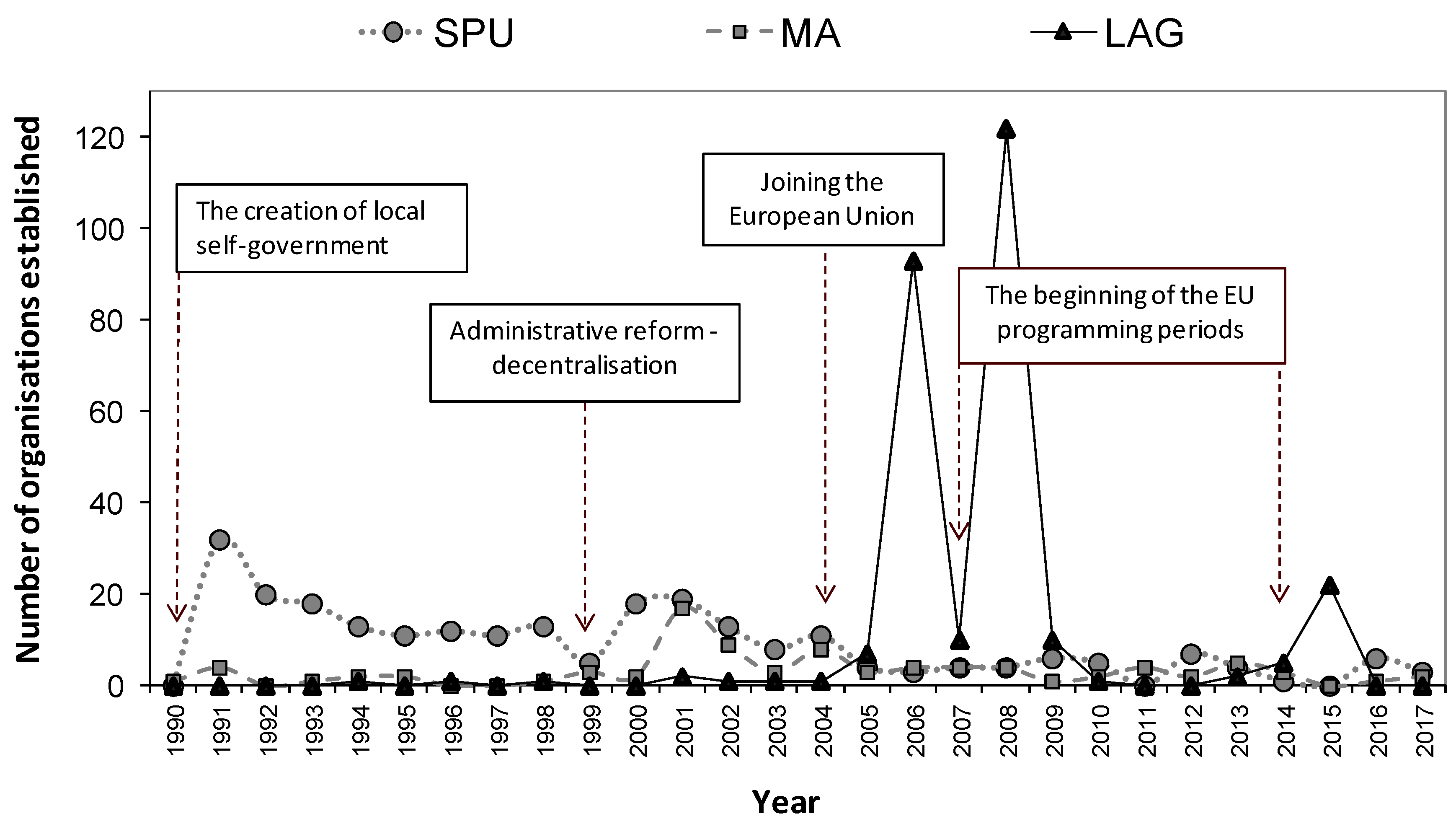
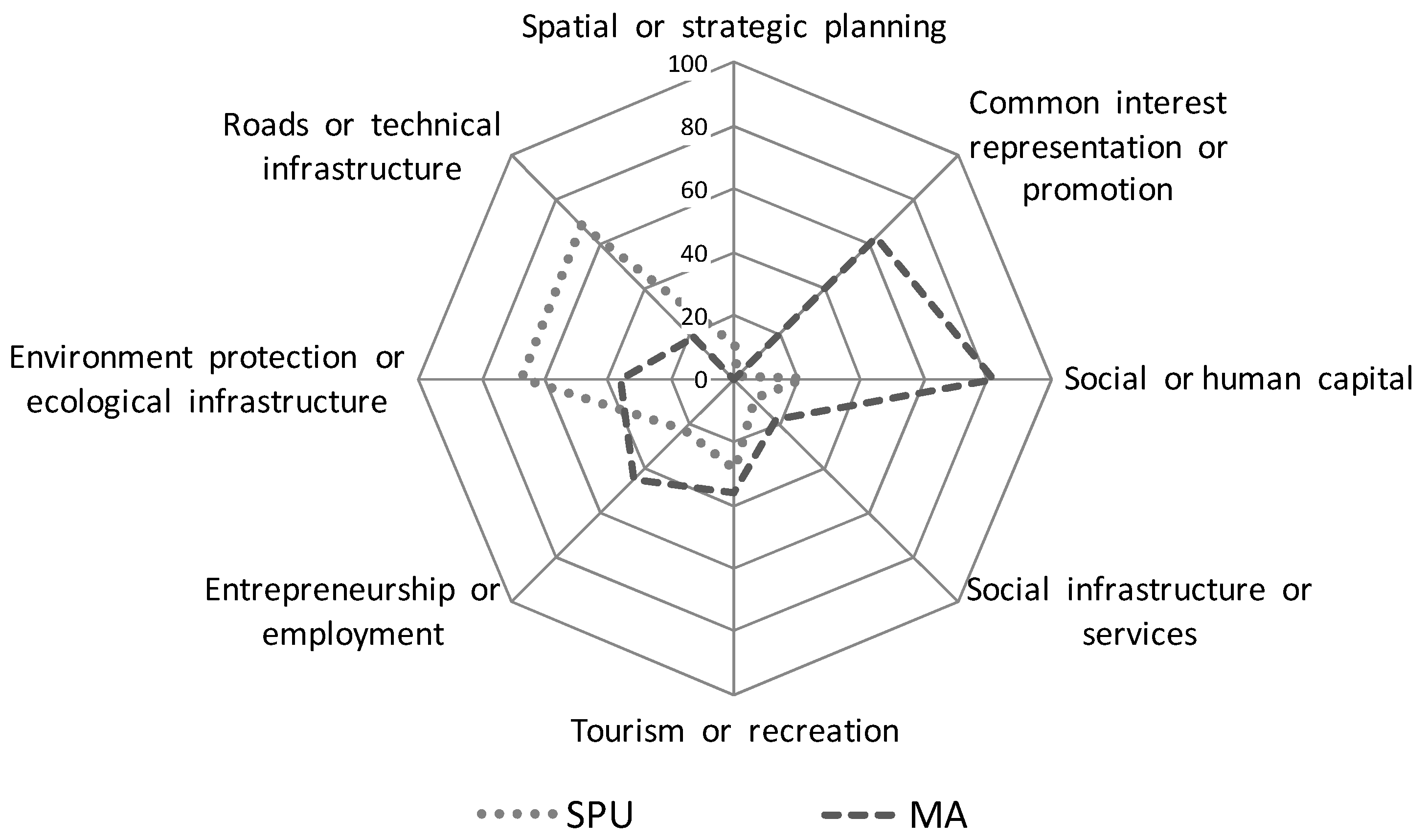
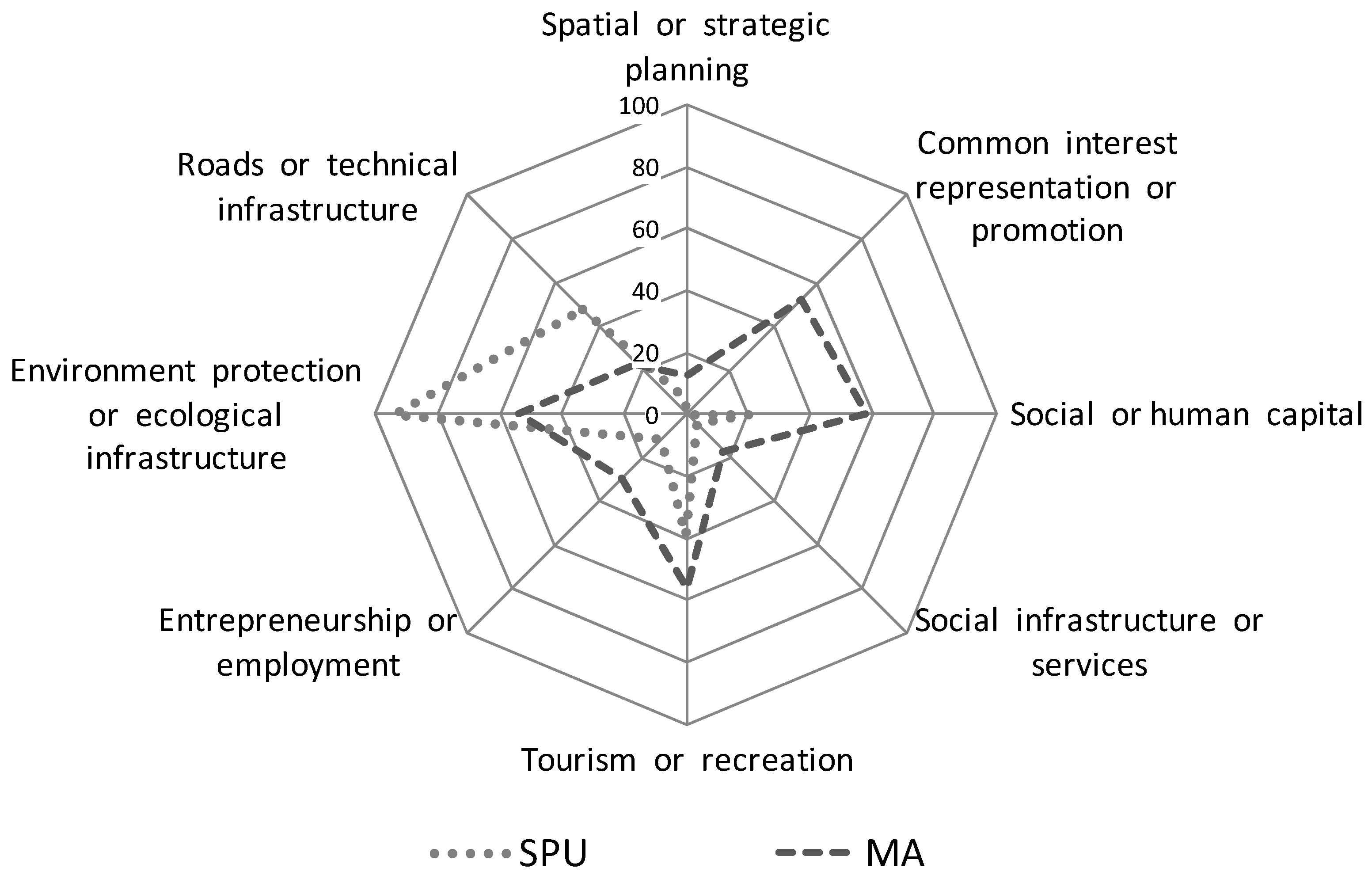
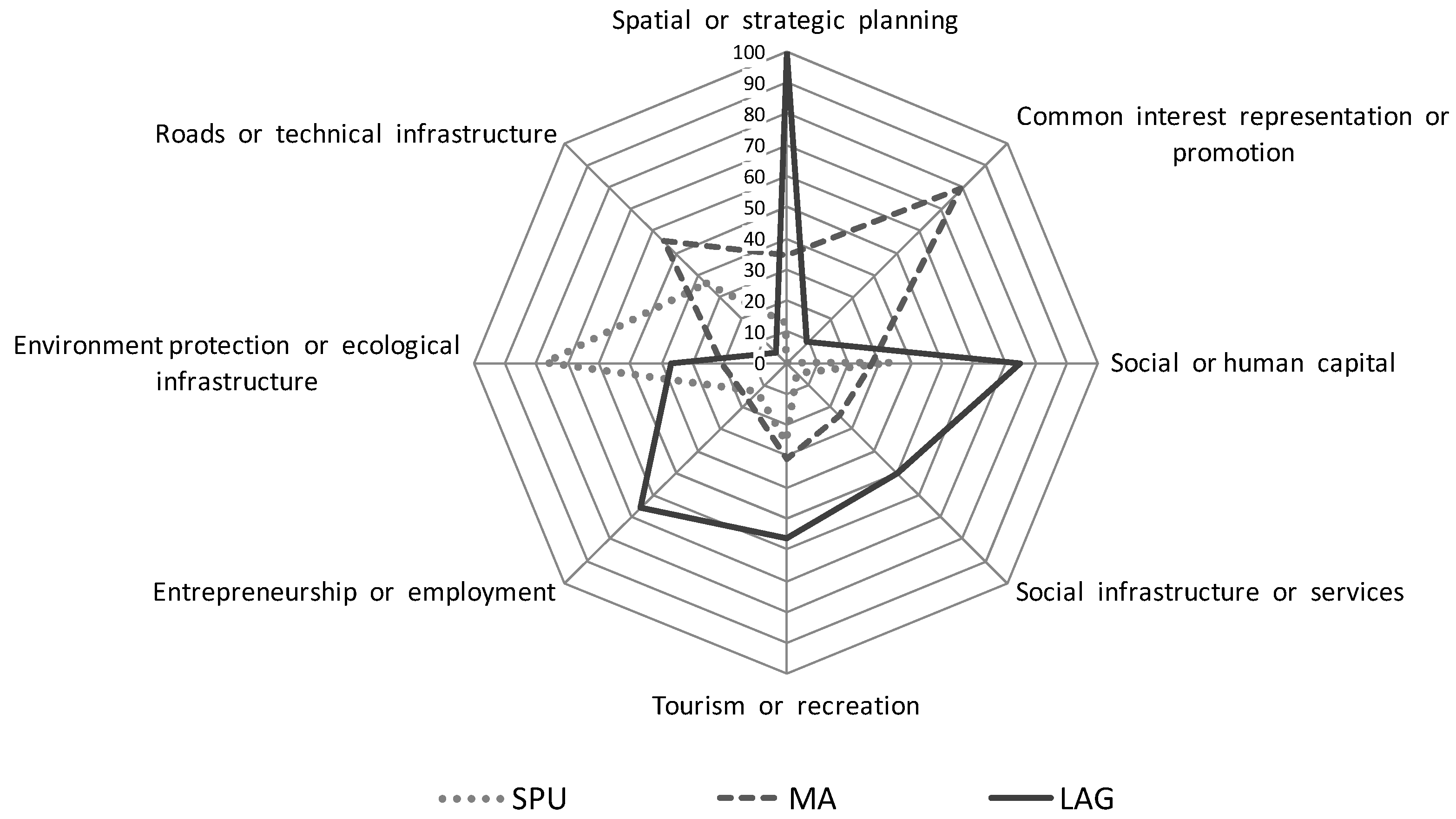
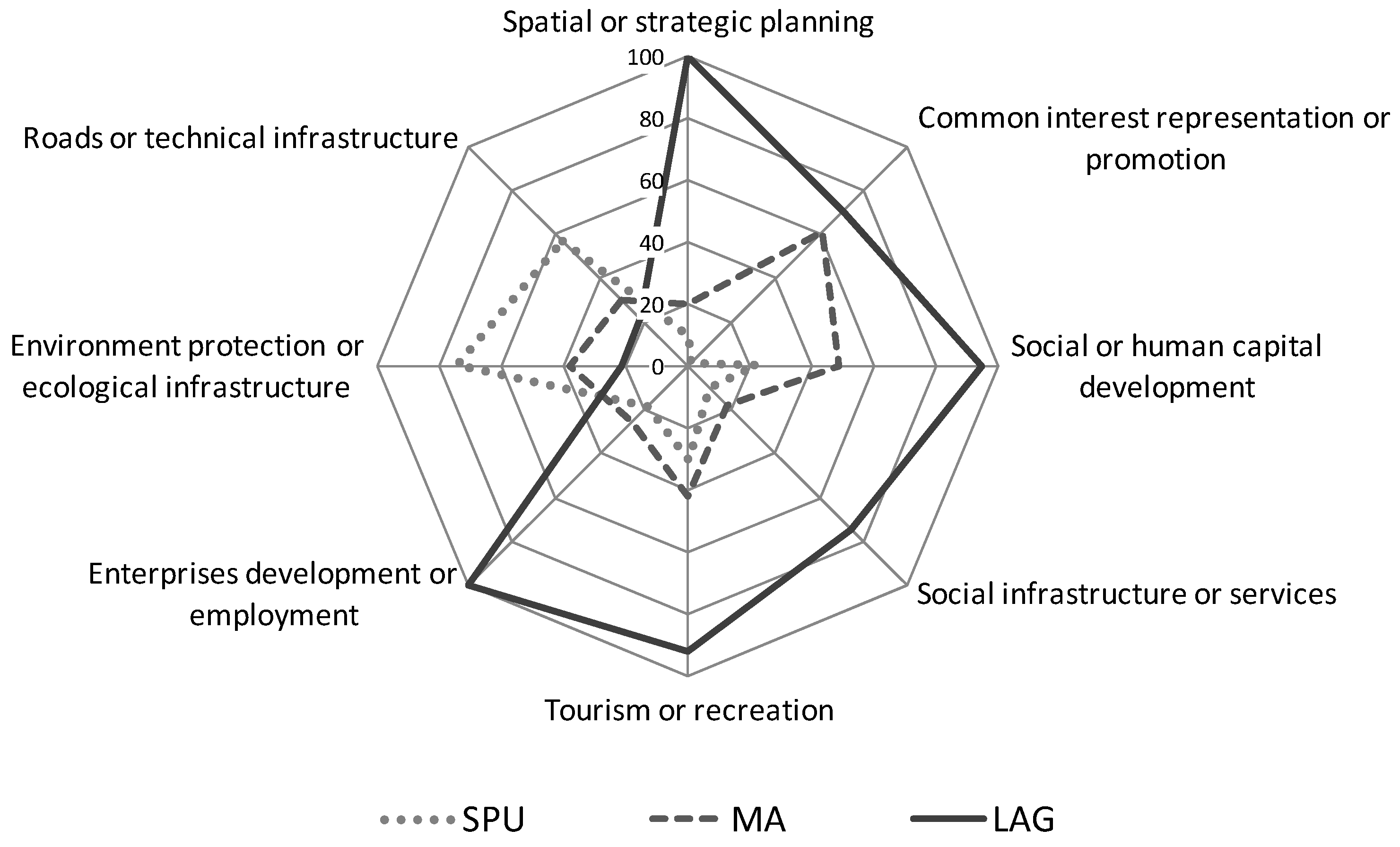
| SPU 1 | MA 2 | LAG 3 | Comments |
|---|---|---|---|
| 27.7 | 35.4 | 71.9 | With “spatial or strategic planning” category |
| 30.3 | 37.6 | 59.6 | Without “spatial or strategic planning” category |
| Period | SPU | MA | LAG | Mean—All Forms |
|---|---|---|---|---|
| 1990–1998 | 28.7 | 37.5 | No LAGs | 33.1 |
| 1999–2004 | 27.8 | 37.8 | No LAGs | 32.8 |
| 2005–2013 | 25.3 | 36.2 | 49.7* | 37.1 |
| 2014–2018 | 17.5 | 32.1 | 71.9** | 40.5 |
© 2019 by the authors. Licensee MDPI, Basel, Switzerland. This article is an open access article distributed under the terms and conditions of the Creative Commons Attribution (CC BY) license (http://creativecommons.org/licenses/by/4.0/).
Share and Cite
Furmankiewicz, M.; Campbell, A. From Single-Use Community Facilities Support to Integrated Sustainable Development: The Aims of Inter-Municipal Cooperation in Poland, 1990–2018. Sustainability 2019, 11, 5890. https://doi.org/10.3390/su11215890
Furmankiewicz M, Campbell A. From Single-Use Community Facilities Support to Integrated Sustainable Development: The Aims of Inter-Municipal Cooperation in Poland, 1990–2018. Sustainability. 2019; 11(21):5890. https://doi.org/10.3390/su11215890
Chicago/Turabian StyleFurmankiewicz, Marek, and Adrian Campbell. 2019. "From Single-Use Community Facilities Support to Integrated Sustainable Development: The Aims of Inter-Municipal Cooperation in Poland, 1990–2018" Sustainability 11, no. 21: 5890. https://doi.org/10.3390/su11215890
APA StyleFurmankiewicz, M., & Campbell, A. (2019). From Single-Use Community Facilities Support to Integrated Sustainable Development: The Aims of Inter-Municipal Cooperation in Poland, 1990–2018. Sustainability, 11(21), 5890. https://doi.org/10.3390/su11215890






